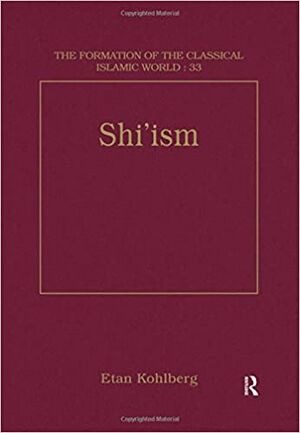Shi'ism (The Formation of the Classical Islamic World)
 | |
| Author | Kamran Scot Aghaie |
|---|---|
| Language | English |
| Genre | Shi'a Historic |
| Published | 2003 |
| Publisher | Routledge; 1er edición |
| Pages | 440 |
The book The Formation of the Classical Islamic World (Shi'ism) examines the social aspects of early Shi’ism, the evolution of its legal systems, the relationships among its various components, or the connections between Shi’ism and Sunnism on the one hand and Shi’ism and other religions on the other.
About the author[edit | edit source]
Etan Kohlberg is an Israeli professor emeritus of Arabic language and literature at the Hebrew University of Jerusalem . He is one of the best experts on the Shi’a , especially the Twelve Shi’a , and Sufi literature. He received his doctorate from 1969–1971 at Oxford University with a dissertation on the relationship between the Twelve Shi’a and the companions of Muhammad. In his books and articles, Etan Kohlberg deals, among other things, with the thinking, history and religious literature of the Twelve Shi’as and the Imamites , with Taqiya in Shiite theology and religion. Conrad is known for his work on medieval Near Eastern social history, Arabic and Islamic medicine, and Arabic, Greek, and Syriac historiography.
About the book[edit | edit source]
This book published in Routledge; 1st edition (August 7, 2003), has 440 pages and best sellers rank of 8,145,854 in Books.
The present book reflects the wide range of scholarly interest in early Shi`ism over the past half century. All major branches of Shi`ism are covered. Some studies are historical in nature, whether dealing with specific events or offering a broad historical perspective. Others focus on literary issues, on the development of doctrine or on the relations between the Shi`i and the non-Shi`i world.
Abstract of chapters[edit | edit source]
Chapter 1: Imamiya[edit | edit source]
The first article of this chapter deals with the formative period of Imami Shi’ism has been the nature of early Shi’ism and the growth of Imami Shi’i thought. The main thesis of the second article in this chapter is that according to the early Shi’a, the right to rule belonged to the Banu Hashim, that is, to all descendants of Muhammad's great-grandfather Hashim ibn 'Abd Manaf. Third article attempts to reconstruct the growth of religious and sectarian dimensions in the early Shi’a. Forth article presents a novel perspective on the beginnings of Imami Shi’ism. one of the defining moments of Shi’i history is the death of al-Hussain at Karbala'. Imami perceptions of this event are treated in the fifth article. He identifies three distinct periods in the early history of Imami Shi’ism. The sixth article surveys the earliest material about the four agents of the Twelfth Imam and summarizes the traditional descriptions of their role. Two early Imami heresiographies are discussed in the seventh article in this chapter.
Chapter 2: Ghulat[edit | edit source]
In this chapter we have two articles that one of them focuses on the diverse meanings of the term ghulat. Ant the others analyses some early ghulat movements, pointing out their major beliefs and tracing possible outside influences, it assumes that various extremist views attributed to Bayan ibn Sam'an are a fabrication and points out that Bayan was the first non-'Alid to lay claim to the imamate and notes that Bayan's allegation that an 'Alid had designated him to be Imam established an important precedent, paving the way for later similar claims.
Chapter 3: Zaydiya[edit | edit source]
Again we have two articles in this chapter. The first one deals with different facets of early Zaydi history and delineates the main events in the history of the first Zaydi state, beginning with the revolt of al-Hassan ibn Zayd against the Ṭahirids and leading to the establishment of an independent 'Alid kingdom in Ṭabaristan and Gilan. The second article focuses on the Kamiliya, whose origins go back to the first half of the second/eighth century.
Chapter 4: Isma’iliya[edit | edit source]
The Isma’iliya among the various Shi’i sects, were the object of the worst distortions among European writers of the seventeenth to nineteenth centuries. The first article in this chapter points to Muhammad al-Nasafi as the first who introduced Neoplatonist ideas to the Isma’iliya, and holds that his system lay at the basis of the writings of the Isma’ili missionary (da'i) Abu Ya'qūb al-Sijistani. The second article surveys the history of pre-Faṭimid Isma'Tlism, extending from the origins of the proto- Isma’iliya in the middle of the second/eighth century to the establishment of the Faṭimid caliphate in 297/909. The author of the third article depicts the anti-Isma’ili version of the beginnings of Isma'ilism, showing that elements of this version may be regarded as historically sound.
Chapter 5: Abbasids[edit | edit source]
The aim of this chapter is merely to mention briefly some of the studies dealing specifically with the nature of the connection between the 'Abbasids and the Shi’a. The first article in this part analyses the meaning of the 'Abbasid call for "al-Riḍa". the author in this article demonstrates that this term refers to someone chosen by consultation and communal agreement (shura), and maintains that the 'Abbasids did not advocate a particular person from among the ahl al-bayt because they did not have a specific candidate in mind. Second article’s author analyses that during the revolutionary phase the 'Abbasids (at least among their closest followers) based their claims on the testament of Abu Hashim but concealed their own identity until the proclamation of al-Saffaḥ as caliph in 132/749. And the last article in this book, deals with the policies of al-Ma'mun towards the 'Alids. The author wishes to show that the caliph's attitude was consistent throughout his reign. His aim was to bring about a reconciliation between 'Abbasids and 'Alids, and he tried to achieve this by adopting largely Zaydi tenets on the imamate.